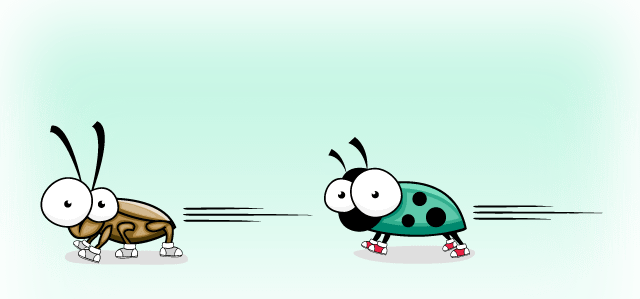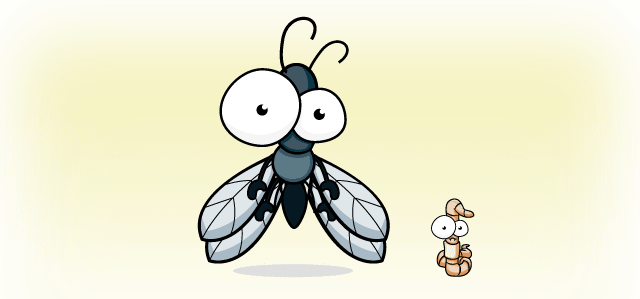
Fastest Flier
Imagine going as fast as you can on your bicycle. Now think of how fast a bug can go. We’re not talking about ‘butterfly’ speed. The Corn Earworm Moth has been known fly an average of 17 miles per hour. The Desert Locust flies faster at an average of 21 mile per hour. Scientists are still working on figuring out how fast other insects can fly. But there is one bug they’ve caught speeding — the Black Cutworm, which has been recorded going at speeds between 60 to 70 miles per hour!

Most Tolerant Of Cold
Bugs can’t put on coats and sweaters when the temperatures start to get freezing cold. You can imagine their surprise when scientists were checking out how well the Pterostichus brevicornis (Kirby), a carabid beetle did in laboratory tests when they cooled down this bug to – 124.6°F. So, it’s not surprising to find this beetle living and thriving in its natural Arctic environment.

Longest Insect
So how long can an insect get? Six inches? Fifteen inches? Would you believe that the Pharnacia serratipes found on the Malay Peninsula has been found to grow almost 22 inches long? There are other LONG, skinny, stick insects found mostly in Indonesia, but so far no bug has been found to top the Pharnacia serratipes.

Most Toxic Venom
There are all types of insects that have the ability to defend themselves by biting or stinging.
However, some that can fly, (Bees, Yellowjackets, and Hornets), creep (Velvet Ants and Assassin Bugs) or eventually turn into certain types of butterflies and moths (Puss Caterpillars, Slug Caterpillars, and Giant Silkworm Moth Caterpillars) are dangerous, because they can inject a toxin venom into their victim. Among these, there is a species of Harvester Ant that is known to have the most toxin venom.
People and animals that are highly allergic to these venomous bugs need to seek medical help as soon as possible.

Most Heat Tolerant
In the deserts around the world, most creatures head for the shade or underground during hottest part of the day in order to stay alive. There three groups of ants known for being excellent desert scavengers, which feed on other insects who died because they weren’t quick enough to get away from the intense heat. Identified by their Latin names, the Cataglyphis live in North Africa, the Ocymyrmex in South Africa, and the Melophorus are found in Australia.
The Cataglyphis group is the winner when it comes to being the best at surviving in the hot Sahara Desert. Their bodies can heat up to over 122°F as they hunt for food on sands that can get as hot as 158°F. If the Namib Desert ant, Ocymyrmex barbiger, was exposed to a 131°F environment, it would collapse in a heat coma within 25 seconds. While five kinds of Cataglyphis can last from 10 to 25 minutes longer in that temperature!
Since they hunt during hottest times of the day, all of these ants move like speeding race cars, and their long legs keep their bodies from dragging along the heated surfaces of the sand and stones. And, did you know that when they rest on dry plants which have relatively cooler surfaces, these ants can ‘off-load’ their excess body heat? Amazing!

Longest Migration
Just think about how tired you would be if you tried to walk over 3,000 miles in less than two months. In 1950, individual swarms of the Desert Locusts, which lived in the dry areas of North Africa, were found to have flown from the Arabian Peninsula to Mauritania on the west coast of Africa, a total of 3,100 that same amount of time.
In 1988, individual locusts hitched a ride on a sub tropical wave of low pressure and travelled an amazing distance, too. From the west coast of Africa, they landed a variety of places —from St. Croix in the West Indies in the northern Caribbean, and south to the east coasts of several South American countries, including Surinam and Guyana — over 2,800 miles from where they were born. This low pressure system also gave birth to a hurricane that year.

Fastest Runner
There are two bugs that are competing for the title of Fastest Runner, and choosing the winner depends on how their speed is measured. You see, the American Cockroach is considered the current record holder, because it was clocked going a maximum speed of just over three (3) miles per hour. However, over a shorter distance, the Australian Tiger Beetle has been recorded going faster. In any case, you can out run both of these bugs on the same course with just a few steps!

Biggest Insect Ever
Dragonflies are known as the ‘Dive Bombers’ of the insect world, because of the way they swoop down to capture their prey. The wingspan of today’s dragonflies can range from about a half inch (0.5″) up to over seven and half inches (7.5″) wide. However, if you lived over 250 million years ago, you would have seen the Meganeura dragonfly hovering over the swamps with a wingspan of over two FEET (24″) wide.

Largest Butterfly & Moth
From the lowland rainforests of New Guinea, the tropical butterfly which has the largest wingspan of eleven inches (11″) is the endangered species known as the Queen Alexandra’s Birdwing.
Then, get ready to stretch out the tape measure when you see a Noctuidae, better known an Owlet Moth, flying overhead. One member of this gigantic family of moths has been recorded with an eye-popping eighteen inch (18″) wing span.
